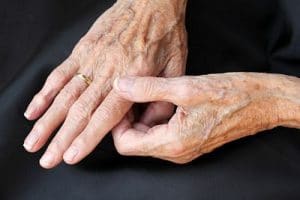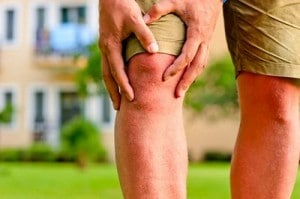Arthritis is one of the most pervasive diseases in the United States and is one of the leading causes of disability. According to the Centers for Disease Control and Prevention, one out of every three Americans (an estimated 70 million people) is affected by arthritis. For most people, arthritis pain and inflammation cannot be avoided as the body ages. In fact, most people over the age of 50 show some signs of arthritis as our joints naturally degenerate over time. Fortunately, arthritis can often be managed with acupuncture.
Acupuncture For Pain Relief

Chinese medicine has been found to be extremely effective at treating the pain and inflammation associated with all types of arthritis (rheumatoid, psoriatic and osteoarthritis). Acupuncture points are selected to reduce pain and decrease inflammation to help the patient live life without the hindrance of pain and stiffness. There is little sensitivity to the insertion of acupuncture needles. They are so thin that several acupuncture needles can go into the middle of a hypodermic needle (the type of needle used to give vaccinations or draw blood). Once the needles are in place, most people relax and some even fall asleep during the treatment.
The length, number and frequency of treatments varies according to severity, onset and type of arthritis as well as the patient’s lifestyle (diet, exercise, sleep, stress relief practices, etc.). Typical treatments last about 45 minutes, with the patient getting treated 1-2 times/week at first and then once the arthritis symptoms are under control, evaluating a maintenance plan such as returning every 4-6 weeks for treatment. Some symptoms are relieved after the first treatment, while more severe or chronic conditions may require multiple treatments.
The popularity of acupuncture for arthritis continues to grow because more and more people have found significant relief from acupuncture and Chinese medicine without the potential side effects that come from Western pharmaceuticals. However, if you are taking medication for your arthritis, acupuncture will not interfere with its effects.

How Can We Help?
Suffering from arthritis pain and inflammation? Our licensed acupuncturist specializes in pain relief including arthritis pain, joint pain, and muscle pain. Contact us today and get started on your journey to living pain free once again.
Homeopathic Medicine is based on the findings of Samuel Hahnemann. Hahnemann was a German physician who lived from 1755 until 1843. During his career, Hahnemann began to take a regular dose of cinchona. After taking this, he began to have mild symptoms of malaria. Hahnemann determined that if a patient is suffering from an illness, he can be given a medicine that would produce similar, yet milder symptoms in a healthy adult.
He used a process called proving to help compile a list of appropriate remedies based on the
In 1812, Typhus was killing thousands. Hahnemann armed with his homeopathic medicines, treated 180 typhus patients. Out of those patients, only two died. He continued working on his theories throughout his life. In 1831, cholera broke out in Europe. He used his protocols to treat cholera. The mortality rate of cholera using conventional treatment methods was more than 50 percent while the mortality rate using homeopathic treatment methods was between 2 and 20 percent.
Dr. Lund was a Danish student of Hahnemann who then trained Dr. Hans Burch Gram. Dr. Gram brought this complementary medicine to New York City in 1825 and opened the first homeopathic practice in the New World. The success of this branch of medicine spurred the formation of the American Institute of Homeopathy in 1844. Since then, Homeopathic Medicine has gained federal recognition, including the 1938 Food, Drug and Cosmetic Act, the Medicare Act of 1965 and the 1987 FDA Compliance Policy Guidelines.
Homeopathic Medicine follows three principles – Likes Cure Likes, Minimum Dose, and Single Remedy.
The first principle of Likes Cure Likes assumes the symptoms are the body’s way to overcome an illness. Practitioners using this principle believe that if a particular ingredient or substance causes a symptom to occur in a healthy person, giving a minute amount of the substance may help cure an illness in an unhealthy person. This Minimum Dose, known as a homeopathic dose, is the second principle. It stimulates a healing response such as inflammation to enhance the body’s self-regulatory and healing processes.
Finally, the third principle is the Single Remedy approach. Homeopathic Medicine normally utilizes only one remedy at a time. This principle seeks to stimulate the body’s natural healing mechanisms. Homeopathic medicine believes that giving two or more medicines can cancel out the response of a particular medicine. The interactions between more than one remedy are not known and can have a negative impact on the body. Additionally, using more than one medicine can make it impossible to determine which remedy is having a positive effect on the body.
Call us today and learn more about how homeopathy can help you and your entire family.
Your BMI score is (Display BMI Score)
Your BMI is in a normal/healthy range for your height (Display Entered HEIGHT) and weight (Display Entered WEIGHT). You are most likely within the recommended weight range for someone of your height, age, and build and consequently are at a lower risk of developing chronic illnesses.
To ensure that you remain at a healthy weight, continue to eat a well-balanced diet that includes plenty of fresh vegetables and fruits, healthy fats, whole grains, low fat dairy products, nuts, beans, eggs, fish, poultry, and lean meat. In addition to a healthy diet, get at least 30 minutes of moderate intensity exercise at least five days a week. For best results, also include strength training exercise at least two days a week.

Your BMI score is (Display BMI Score)
Your BMI is in an Overweight range for your height (Display Entered HEIGHT) and weight (Display Entered WEIGHT).

Typically, those with a higher BMI have more body fatness. Being overweight, you are at an increased risk of a number of health conditions and diseases, including:
It is advisable you speak with your integrative healthcare provider about the best weight loss approach for your unique health, dietary needs, and physical activity levels. Our health coach can work with you to set actionable and realistic goals and help you get started on your journey to optimum health.

For healthy and sustainable weight loss, you may need a combination of increased physical activity and calorie restriction. When substantial weight loss is necessary to reduce the risk of serious illness or death, significant lifestyle changes must be embraced. This includes some stress management techniques like yoga, tai chi, meditation, deep breathing exercises, and guided imagery.
Exercise is essential when it comes to weight loss. As with any activity, you should begin slowly and work your way up to more challenging fitness routines. Experts typically recommend low impact cardio exercises like walking or swimming. In addition to aerobic exercises, try to incorporate strength training exercises into your workout routine.
Having an elevated BMI increases your risk of illness and disease. Reducing your weight through diet and exercise decreases your risk of disease. In addition to this, reducing your overall weight increases your energy levels. As your energy levels increase, you will be able to perform more exercise, which will further improve your weight loss efforts, and as you begin to lose weight, you will feel better about yourself and your self-esteem will begin to improve
Your BMI score is (Display BMI Score)
Your BMI is in a Obese range for your height (Display Entered HEIGHT) and weight (Display Entered WEIGHT).

Typically, those with a higher BMI have more body fatness. Being obese, you are at an increased risk of a number of health conditions and diseases, including:
It is advisable you speak with your integrative healthcare provider about the best weight loss approach for your unique health, dietary needs, and physical activity levels. Our health coach can work with you to set actionable and realistic goals and help you get started on your journey to optimum health.

For healthy and sustainable weight loss, you may need a combination of increased physical activity and calorie restriction. When substantial weight loss is necessary to reduce the risk of serious illness or death, significant lifestyle changes must be embraced. This includes some stress management techniques like yoga, tai chi, meditation, deep breathing exercises, and guided imagery.
Exercise is essential when it comes to weight loss. As with any activity, you should begin slowly and work your way up to more challenging fitness routines. Experts typically recommend low impact cardio exercises like walking or swimming. In addition to aerobic exercises, try to incorporate strength training exercises into your workout routine.
Having an elevated BMI increases your risk of illness and disease. Reducing your weight through diet and exercise decreases your risk of disease. In addition to this, reducing your overall weight increases your energy levels. As your energy levels increase, you will be able to perform more exercise, which will further improve your weight loss efforts, and as you begin to lose weight, you will feel better about yourself and your self-esteem will begin to improve.
Your BMI score is (Display BMI Score)
Your BMI is in a Underweight range for your height (Display Entered HEIGHT) and weight (Display Entered WEIGHT).

If is advisable you speak with your integrative healthcare provider about managing your weight for your unique health, dietary needs, and physical activity levels.
Our health coach can work with you to set actionable and realistic goals and help you get started on your journey to optimum health.